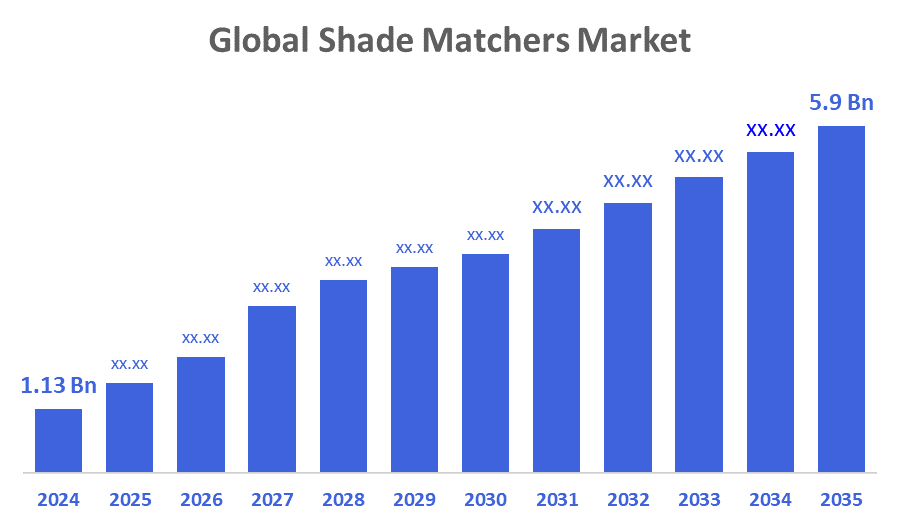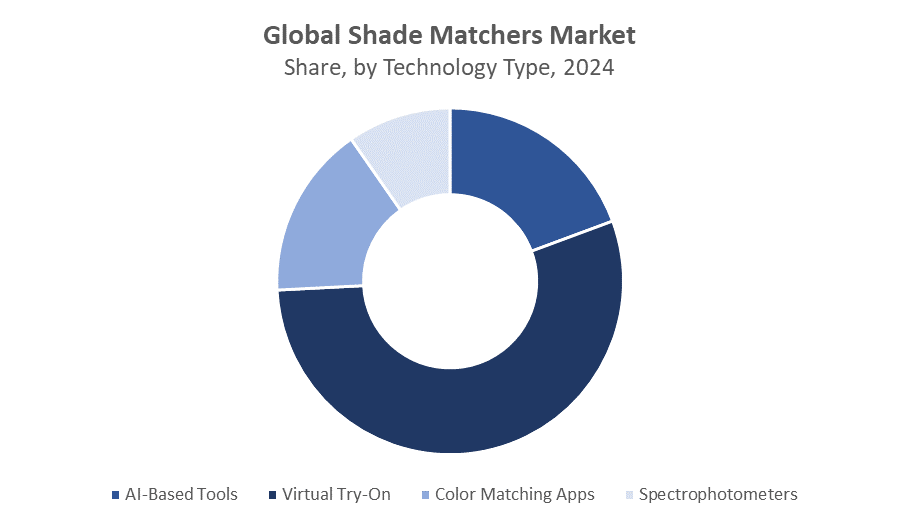Global Shade Matchers Market
Global Shade Matchers Market Size, Share, and COVID-19 Impact Analysis, Impact of Tariff and Trade War Analysis, By Technology Type (AI Based Tools, Virtual Try On, Color Matching Apps, and Spectrophotometers), By End Use (E Commerce, Retail Stores, and Mobile Applications), and By Region (North America, Europe, Asia-Pacific, Latin America, Middle East, and Africa), Analysis and Forecast 2025 - 2035
Report Overview
Table of Contents
Shade Matchers Market Summary, Size & Emerging Trends
According to Decisions Advisors, The Global Shade Matchers Market Size is expected to Grow from USD 1.13 Billion in 2024 to USD 5.9 Billion by 2035, at a CAGR of 19% during the forecast period 2025-2035. Key trends include rising demand for inclusive shade options, wider skin tone representation, more brands using virtual try on and augmented/AI driven shade matching tools, and increased integration of these tools into e commerce. Consumers are frustrated with wrong foundation shades, pushing demand for accuracy.

Key Market Insights
- Asia Pacific is forecast to grow fastest over the forecast period.
- AI, virtual try on, and spectrophotometry are driving technology developments.
- Shade match tools with greater inclusivity (undertones, skin tones) are becoming differentiators for brands.
Global Market Forecast and Revenue Outlook
- 2024 Market Size: USD 1.13 Billion
- 2035 Projected Market Size: USD 5.9 Billion
- CAGR (2025-2035): 19%
- Asia Pacific: Largest market in 2024
- North America: Fastest growing market
Shade Matchers Market
The shade matchers market revolves around technologies and tools designed to help users identify the most suitable foundation or cosmetic shade for their skin tone. These include AI-powered platforms, augmented reality (AR) virtual try-on tools, spectrophotometers, and smartphone camera-based applications. Shade matchers play a key role in minimizing cosmetic mismatches, which not only improves customer satisfaction but also helps reduce product return rates in online beauty purchases. Their popularity is driven by the growing consumer focus on personalization, inclusivity, and digital convenience. These tools allow users to make confident shade choices remotely, bridging the gap between e-commerce and in-store experiences. With beauty brands increasingly focusing on diverse skin tones and tech innovation, shade matchers are becoming essential in the modern beauty ecosystem.
Shade Matchers Market Trends
- More beauty brands adopting AR/virtual try on technologies.
- Expanding shade libraries to include more skin tones and undertones.
- Cross brand shade matching to help consumers match existing shades across brands.
- Smartphone camera plus AI becoming an accessible method vs. dedicated hardware.
Shade Matchers Market Dynamics
Driving Factors:
The shade matchers market is propelled by growing consumer demand for personalized beauty experiences
The shade matchers market is propelled by growing consumer demand for personalized beauty experiences, especially in foundation and complexion products. The surge in online shopping for cosmetics increases the need for accurate shade matching to reduce returns and dissatisfaction. Technological advances in AI, machine learning, and computer vision allow tools to analyze skin tone in real time, enhancing user experience. Rising awareness around inclusive beauty and the need to cater to all skin tones is pressuring brands to adopt shade-matching solutions. As consumers seek convenience, accuracy, and diversity in beauty offerings, the use of digital shade matching is rapidly gaining momentum.
Restrain Factors:
The shade matchers market faces limitations due to external variables like inconsistent lighting
Despite advancements, the shade matchers market faces limitations due to external variables like inconsistent lighting, camera resolution, and screen calibration, all of which can affect shade accuracy. Developing precise, high-performance shade-matching systems requires costly hardware and sophisticated algorithms, limiting accessibility for smaller brands. Data privacy concerns also arise when skin images are captured, especially if biometric or sensitive data is stored. Additionally, the lack of standardization across brands and platforms leads to inconsistencies in recommendations. Consumer trust is another hurdle, as some users remain skeptical of AI-based or virtual results versus physical swatching in traditional retail settings.
Opportunity:
Emerging markets, where beauty consumption is rising, present new growth frontiers
There are substantial opportunities for shade matchers in the integration of advanced AR/AI tools into both online and in-store shopping environments. Collaborations between beauty and tech companies can yield scalable, user-friendly solutions. Emerging markets, where beauty consumption is rising, present new growth frontiers, especially with increasing smartphone penetration. Subscription models and app-based platforms could offer continuous skin tone assessments, seasonal adjustments, and product recommendations. As inclusivity becomes a critical metric for brand loyalty, tools that support wider skin tone databases and multicultural representation will gain strong market traction. Retailers can leverage shade matchers to enhance customer loyalty and reduce product waste.
Challenges:
Managing customer expectations while dealing with technological constraints
A key challenge is achieving consistent and accurate color analysis under varying lighting conditions and across different skin undertones. The technology must also handle real-world complexities like skin blemishes, makeup, or lighting reflections. Ensuring robust user data protection and gaining regulatory clarity around biometric data use is vital. Additionally, beauty trends change rapidly requiring tools to update shade ranges and suggestions frequently. Making the technology simple, intuitive, and accessible for all users, regardless of digital literacy, is another concern. Finally, managing customer expectations while dealing with technological constraints and avoiding overpromising features remains a delicate balance for developers and brands.
Global Shade Matchers Market Ecosystem Analysis
The shade matchers market ecosystem comprises technology providers, beauty and cosmetics brands, retailers (both online and offline), AI/AR software developers, and device manufacturers. Key enablers include smartphone cameras, spectrophotometry tools, and cloud-based AI platforms that analyze skin tone data. Strategic partnerships between tech companies and beauty brands are vital for innovation and scale. Consumers, especially online shoppers, play a central role in adoption. Regulatory bodies also influence ecosystem development by setting standards for data privacy and product claims.
Global Shade Matchers Market, By Technology Type
Virtual Try On / AR Enabled Tools hold the largest share of approximately 63% in 2024. This technology is widely adopted across online beauty platforms and retail applications, allowing users to visualize foundation shades on their skin in real-time. Its compatibility with smartphones and ease of use drive consumer confidence and reduce returns, making it the most popular shade matching tool globally.

AI Based shade matching tools are the fastest-growing segment, expected to achieve a CAGR of around 27%. These tools utilize machine learning and computer vision to provide highly accurate skin tone analysis and personalized shade recommendations. Increasing demand for inclusivity and customization in beauty products fuels their rapid adoption across mobile apps and e-commerce platforms.
Global Shade Matchers Market, By End Use
E-commerce platforms hold the largest share, accounting for approximately 55% of the market in 2024. The rise of online beauty shopping combined with the demand for precise virtual shade matching tools drives this segment. These platforms help reduce product returns by ensuring customers find the right shade the first time, enhancing purchase confidence and customer satisfaction. They are increasingly integrating AI and AR technologies for better user experience.
Mobile applications are the fastest-growing segment in the shade matchers market, with an expected CAGR of around 28%. This rapid growth is driven by the widespread adoption of smartphones globally, making these tools accessible to a larger and more diverse audience. Consumers increasingly prefer the convenience of on-the-go shade matching, allowing them to explore and select cosmetic shades anytime, anywhere without visiting a store. These apps leverage advanced AI and machine learning algorithms to provide highly personalized recommendations based on individual skin tones, lighting conditions, and user preferences.
Asia Pacific is expected to be the fastest-growing region in the shade matchers market, with a projected CAGR of around 30%.
This growth is driven by rising beauty consciousness, increasing smartphone penetration, and a growing middle-class population eager to adopt new beauty technologies. The region’s expanding e-commerce sector and digital-savvy consumers further fuel demand for convenient and personalized shade-matching solutions.
North America holds the largest market share, approximately 42% in 2024.
This dominance is due to widespread adoption of beauty technology, strong e-commerce infrastructure, and high consumer spending on personal care products. The presence of leading beauty brands and advanced retail ecosystems supports sustained market leadership in this region.
WORLDWIDE TOP KEY PLAYERS IN THE SHADE MATCHERS MARKET INCLUDE
- X-Rite, Inc.
- Datacolor
- Hunter Associates Laboratory, Inc.
- Konica Minolta, Inc.
- BYK-Gardner GmbH
- Techkon GmbH
- 3nh Technology Co., Ltd.
- Shenzhen Aotu Technology Co., Ltd.
- Axis Manufacturing Corporation
- Gardner Laboratory, Inc.
- Others
Market Segment
This study forecasts revenue at global, regional, and country levels from 2020 to 2035. Decisions Advisors has segmented the shade matchers market based on the below-mentioned segments:

Global Shade Matchers Market, By Technology Type
- AI Based Tools
- Virtual Try On
- Color Matching Apps
- Spectrophotometers
Global Shade Matchers Market, By End?Use
- E Commerce
- Retail Stores
- Mobile Applications
Global Shade Matchers Market, By Regional Analysis
- North America
- US
- Canada
- Mexico
- Europe
- Germany
- UK
- France
- Italy
- Spain
- Russia
- Rest of Europe
- Asia Pacific
- China
- Japan
- India
- South Korea
- Australia
- Rest of Asia Pacific
- South America
- Brazil
- Argentina
- Rest of South America
- Middle East & Africa
- UAE
- Saudi Arabia
- Qatar
- South Africa
- Rest of the Middle East & Africa
Check Licence
Choose the plan that fits you best: Single User, Multi-User, or Enterprise solutions tailored for your needs.
We Have You Covered
- 24/7 Analyst Support
- Clients Across the Globe
- Tailored Insights
- Technology Tracking
- Competitive Intelligence
- Custom Research
- Syndicated Market Studies
- Market Overview
- Market Segmentation
- Growth Drivers
- Market Opportunities
- Regulatory Insights
- Innovation & Sustainability
Report Details
| Pages | 175 |
| Delivery | PDF & Excel via Email |
| Language | English |
| Release | Sep 2025 |
| Access | Download from this page |
